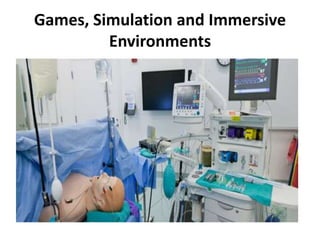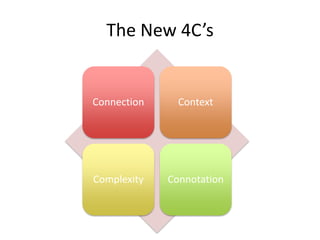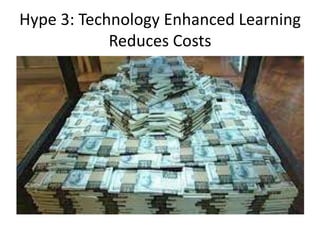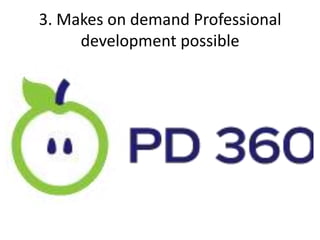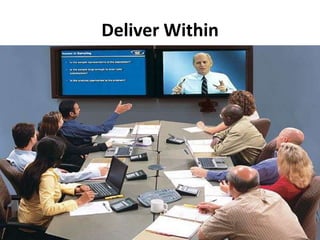Ctf version 2
- 1. Technology and the Future of Teaching & Learning in Canada Maxim Jean Louis, President and CEO, Contact North | Contact Nord and Stephen Murgatroyd, Chief Innovation Officer, Contact North| Contact Nord
- 4. 2. Adaptive Assessment / Curriculum
- 5. 3. Networked & Global Learning
- 6. 4. Open Digital Resources
- 7. Games, Simulation and Immersive Environments
- 8. The Old 4C’s Collaboration Creativity Communication Critical Thinking
- 9. The New 4C’s Connection Context Complexity Connotation
- 10. Top 3 Hypes HYPE VERSUS REALITY
- 11. Hype 1. Students are Digital natives.
- 12. Hype 2: Technology improves outcomes
- 13. Hype 3: Technology Enhanced Learning Reduces Costs
- 14. Hype 4: Personalization of learning
- 15. Hype 5. Video is King
- 16. The GOOD NEWS THE WORK OF TEACHERS AND THE TASK OF TEACHING
- 17. 1. Makes collaboration and cooperation possible faster
- 18. 2. Gives Teachers More Control over Learning Resources
- 19. 3. Makes on demand Professional development possible
- 20. The Not So Good News FEARS, FRIGHTS AND HORRORS
- 21. 1. Pressures On Teachers for More..
- 22. 1. Teacher Performance Evaluation by Video (edTPA)
- 23. 2. Challenging Teachers to Comply
- 24. 3. Impact on Professional Accountability
- 25. 4. Technology as a Distraction for Learners
- 26. WHAT TO DO ?
- 27. Context: We Haven’t Seen Anything Yet
- 28. Think Ahead
- 29. Deliver Within
- 30. Lead Across
Editor's Notes
- What this presentation will do is look at5 developments in the use of technology in classrooms – real developments taking place now.5 Myths about online learning and technology enhanced learningHow technology is impacting teachersWhat some of the fears are and how real these may beAnd end with the question – what should we be doing hereThere is a balance to be found between leveraging technology to support learning and being concerned about the way technology is a part of a change to the nature of schooling – we need to find this balance.
- There are a great many developments taking place. We highlight those that are the most common and have the most traction at this time...
- Rather than using the classroom for instruction – instructors use the classroom as a laboratory, project headquarters and a place where real and deep interaction takes place. The focus is on experience.Students work in teams on projects or in groups on co-creating knowledge.Instruction takes place online outside the classroom. They find out WHAT they need to know through the use of instructor selected multi media material and learning resources.Students also track their learning using blogs and other tools (SO WHAT) and are required to present their learning and its implications (NOW WHAT).Flipped classrooms are growing in high schools and in post-graduate work and they are part of the normal work of teaching.To some extent, there is nothing new here (except for the language). What is now more possible is to create very rich resource centres (WHAT) and to have much more reflective activities (SO WHAT) and much richer project work all enabled by technology.
- Technology now permits us to use predictive analytics to look at student progress daily, weekly, monthly, quarterly and to look at patterns both in terms of individual development, groups of students or teacher impact.One of the things analytics is enabling is differentiated instruction – indeed, adaptive curriculum leads to adaptive assessment.Knewton, the provider of a widely deployed adaptive learning platform that uses student data to personalize learning content. The platform is continuously adaptive; it responds in real time to the activity of each user on the system and adjusts to provide the most relevant content. Knewton is able to capture every move a student makes – scores, speed, accuracy, delays, keystrokes, click-streams and drop-offs. The platform collects this data and the software adapts to challenge and persuade the user to learn based on his/her individual style.The challenge here is how much analytics and assessment do we need and use. In some school systems (Abu Dhabi), students are tested daily and their competency development mapped together with an assessment of the “value added” to each student by the teacher each day.How far down this road do we want to go – if we want to go at all?Simon Buckingham Shum and Rebecca Ferguson (2011) identified some of the concerns on using analytics in teaching and learning as:Not genuinely promoting meaningful learning.Devaluing the role of teachers/mentors, who will never be replicated by machine intelligence.Disempowering learners by making them rely on continuous machine feedback rather than developing their own meta-cognitive and learning-to-learn skills.Devaluing the essence of deep learning and scholarship, through assigning short-term financial value to superficial indicators.Raising ethical issues about the use, re-use and merge learner data, both public and privateData, by itself, does not mean anything and it depends on human interpretation and intervention. Analytics may provide a valuable insight into a student’s learning, but if teachers do not take actions to intervene, then it will not help to improve the academic performances. Furthermore, contextual data that are not always found in learning management systems, should also be recorded and considered, in order to provide full pictures of students’ learning and performance.Reference: Social Learning Analytics, http://tinyurl.com/9kt3cjp
- Facebook, LinkedIn and other social networks have a learning purpose…they can be used to create community and rapidly share information..But FB is also a challenge and a problem…Mark Neufeld in Victoria (Institute for Global Solutions) and Terry Godwalt in Edmonton Public (Centre for Global Education) have been using project based learning enhanced with technology for several years.Terrywe partner over 10,000 students every year from every corner of the planet focusing on Peace and Global Education and Higher Level Learning and Research.e.G Senate report by students across Canada on energye.G UN study of the health and future of the forestMarkClassroom learning has been complemented by seminars and our exciting Speaker Series, with journalist Gwynne Dyer and best-selling author Ronald Wright sharing their ideas with our students in September, and guests such as Elizabeth May, Rick Kool, and Shawn Atleo scheduled to appear in the near future. Learning has also been extended beyond the classroom. IGS students have begun to immerse themselves in hands-on work that matters – from organic gardening and watershed restoration to micro-credit lending and renewable energy research.The IGS is less about the problems and limitations and more about the tools, models, and ideas that already exist for overcoming them. Students are quickly coming to realize that another world is not just possible, it's here. We only need to put the pieces together.Technology enabled connectivity creates context for global studies, creates a basis for project work and creates the opportunity for relationships..We see this in Alberta in the relationships between students in the Finland – Alberta partnership.
- Whether is a simple video (iTunes University), a course (a MOOC or a high school course), a lesson or a part of a lesson it is highly probable that the material is available or could be made available quickly at no or next to no cost.This is a massive development – free to use course material, open source course designs, free to use video, simulations, online labs are growing exponentially.Also growing is the availability of digital textbooks – with some jurisdictions mandating their use.Publishers are also adapting to these developments. Teachers can “customize” texts, using materials from a variety of different texts to “construct” the text they need for their class. They can also include their own materials in these “custom” books. We will see more and more of this, especially as Pearson adopts this as the basis for their new approach as a Learning Corporation (versus just being a publisher).Not only can teachers access these materials, they can also contribute to the banks of open source resources available. However, what should be insisted upon is some kind of quality assurance. In one study of the math resources in one jurisdiction it was found that some 20% of the material contained errors of fact or incorrect calculations or processes.
- Gamification and the use of simulation is growing quickly, especially as the technology requirements for creation of simulation and games.This began in the mid 1980’s (Math Blaster, Legend of Zelda, Pirates) and has developed along with the technology.Now students are building education games and simulations (e.g. Gamestar Mechanic and Quest to Learn) or are experiencing them – from fitness work (WiiFit) to biology (Immune Attack) and Shakespeare (Arden).The Banff Centre recently hosted an international gathering of those working on immersive learning – enabling learners to “live in” an experience. For example, they created a simulation in which Abraham Lincoln stepped out of a small dinner and “walked into” the classroom and engaged in a conversation with students.In health related education, nurses and doctors are using simulators to train for complex skills and in aviation flight simulators are used to train pilots and aircraft interior simulators are used to train flight crews. We will see more and more use of simulators and virtual reality as the technology gets easier for designers and educators to create these experiences.
- When technology enhanced learning was really taking off in the mid 1990’s we talked about these 4C’s – collaboration through connectivity and communication enabling creativity and critical thinking. But these are fading in terms of their prominence in the conversation and we now talk about the new 4C’s.
- The new 4C’s are very much focused onCONNECTION – “always on” learning and networksCONTEXT – using learning activities and projects to create context and develop understanding.Encourage students not to look at things simply but to understand COMPLEXITYAnd for students to see their learning in terms of meaning making (mindful learning) or CONOTATIONThis is the way in which many educators are thinking.Some, however, seem to have lost the plot suggesting that students no longer need to know things (they can always look them up) but need to know the how of learning.Few support this, but this kind of thinking is present in the Faculties of Education in some universities.
- Most teachers are very busy.Most teachers work far more hours than they are paid for and, while there are great many great things happening in a great many schools, what is real in terms of technology enhanced learning? What is hype and what is real?We make 3 suggestions…
- This idea has several roots, but is actively promoted by a number of speakers, thinkers / writers and corporations.It is true that many students see technology more like a utility than a novelty.There are more smartphones on the planet now than there are people – and this technology is not yet a decade old.Tablet technologies, lap and desk top computers appear ubiquitous.BUTThe digital divide is very real – based on poverty, culture and family circumstance.Not all have access to reliable broadband or appropriate technology and not all know how to use it well. 3. The adoption curve applies just as much to families and students as it does to teachers.
- Technology driven instruction enables higher results – this is the claimFewer teachersBetter retention and engagementThe results of a major meta-analysis by DoE US show:Blending works: This study adds to a growing consensus around the conclusion that the most effective type of instruction combines the online and face-to-face environments. Other meta-analyses which reach this conclusion are Bernard et. al (2004) and Zhao et. al (2005). Adapting instruction works: Means\\' work supports the thoughtful adaptation of instructional methods and materials to the online environment, and forthcoming research by OIT\\'s Research and Evaluation Team reaches a similar conclusion. Self-directed online learning is not the best: Collaborative or instructor-directed online learning achieved results superior to those attained through independent, self-directed online learning, which may provide a partial explanation for why online learning has not proven to be a money-saver for cash-strapped educational institutions.
- Last year, a suburban school district in Virginia spent about $89 million for technology hardware, software and labor dedicated to managing technical systems. But, a host of harder to calculate indirect costs raised the total cost to own technology for the 166,000-student district to approximately $233 million – close to $1,500 per student. (see http://www.peterli.com/spm/resources/articles/archive.php?article_id=669)Alberta has spent close to $2 billion on technology for schools since 1998 – almost entirely on hardware, with a small % of these investments focused on professional development.The real costs of education are the costs of relationships – technology doesn’t replace these costs, they are in addition.So the question isn't just what does technology cost per student it is what value can we show technology adds to the students experience and to learning outcomes?A recent US study suggests these four conclusions:Technologies with high fixed costs and low variable costs—such as television and radio—can be quite inexpensive, if they serve large numbers of students. They yield greater economies of scale. 2. Technologies with high variable costs, and that work in conjunction with conventional teaching—such as personal computers—are unlikely to bring any cost advantage. Indeed, they may be quite expensive. 3. Technologies that replace conventional teaching, rather than complement it, are likely to have a cost advantage. Such technologies may allow setting up new programs.The question is, whatdoes it take to make technology effective, and how much does that cost? In economic terms, we’re talking about cost- effectiveness. that are cheaper per student than are traditional approaches. For this reason, the most successful applications of educational technology in developing countries have been in distance education programs, which provide services that conventional approaches cannot afford to provide. 4. Technologies that are relatively self-contained, and require only minimal pedagogical input and managerial support at the local level may have a cost advantage. Again, radio and television stand out in this category. Some forms of programmed learning may also fall into this category. (see http://www.techknowlogia.org/TKL_Articles/PDF/17.pdf)
- The claim is that technology liberates teachers from “batch processing” so that they can focus on individual needs of students and engage in differentiated instruction.Personalization depends on the conditions of practice – the support available to teachers, preparation time and class size.All of the evidence on differentiated instruction is that it is a high level very professional teacher skill that can be aided by technology, but is driven by teacher own skill and confidence as well as the level of support available for teachers, including preparation time.Personalized learning is a new topic within the field of education. It has led to debates in both the UK (2006 to present) and Canada (2010) where some educators are concerned that it could diminish the relational and ethical dimensions of education. Andy Hargreaves and Dennis Shirley in The Fourth Way caution about the need for learning to more than competency in test scores and completion of online “activities”. They suggest that the purpose of education is about deep learning and a personal mastery of knowledge.All of the different parties to the ongoing debates about personalized learning agree that schools should become more flexible and adaptive in responding to the diverse needs and interests of students. They all agree that there is great potential in new technologies. However, they differ in the nature of their criticisms of traditional schools and curricula and in the degree of confidence in the role of technology in contemporary society.
- The Khan Academy began as a father seeking to develop simple resources to help his children and soon expanded into a business which has attracted global attention.The idea is simple – basic instruction can be provided by video. Video can be paused, rewound, played over and over again.In many of the Massive Open Online Courses which began to appear in volume this year (college and university level, but high school MOOC’s are planned) video is king. It is presented in 3-10 minute chunks and interspersed with quizzes, activities and other tasks (web safari’s for example) to “liven things up”. But a great many of the videos are not well designed, presented or edited.Students use the video repeatedly until they understand the task, master the knowledge and skill.Class time is then spent on activities – back to the flipped classroom.This can be helpful where, in large parts of rural Canada, equity is a real challenge – how do students in Labrador get access to High School physics or chemistry?But video can be very dull – one student described it “as a way of lowering the unit cost of boredom”. Is video instruction (as opposed to immersive media) really all that effective?
- 3 pieces of good news for professional teachers that relates directly to technology availability.
- On a more positive note, networks of teachers collaborating through curriculum groups, special interest groups or other networks are growing fast.Lesson plans, online resources and learning assessment protocols are being shared together with helpful “hints” and “effective practice” models.But with this comes some dangers.Twitter and Facebook can get teachers into trouble (not to mention politicians).
- Teachers have terrific access to a large volume of video, audio, images, simulations, games and learning resources “just in time”. Rather than relying on the textbook or the store cupboard or the local teachers store or the library, they can access powerful material.For example, look at the new material in an APP from Oxford University Press, like The Waste Land by T S Eliot – audio recording, critical reflections, copies of the manuscript, T S Eliot talking about it and historical analysis of the stages of critical thinking about this poem. Similar APPS exist for the Shakespeare Sonnets and many other resources in science, language arts social studies, history, music, fine arts and so on…so much rich resources..The challenge the teacher has, especially given cuts to support for library services, is finding the materials, assessing them (quality assurance) and selecting them…more time..Also, they each cost money (even if they are free to users, they require bandwidth).
- Of particular interest to many teachers, school districts and the profession are changing designs for professional development.PD has often been a “hit and miss” business, with teacher conventions and PD days varying in quality and relevance. Increasingly, school based PD or cluster PD (groups of staff by interest or groups of schools partnering) is becoming more common.A growing component of PD – linked tov personal growth plans where these are in place – is “on demand” PD – using technology to make powerful, relevant and professionally created PD available. In Ontario, Advanced Qualifications (AQ) offered by the teacher union or the Core Community platform developed by Teachers Media International (TMI), with rich and Canadian content are examples of these developments.
- Linda Duxbury of Carleton University has been studying teachers and their work-life balance. He work suggests that teachers are working 56 hours a week (ore more)..Key to this is what teachers call “administrivia” and what central office staff call “ministrivia”. But also key is the growing responsibility of teachers for managing “inclusion” and the challenge of differentiated instruction, personal learning objectives for each student and the need to document and file lesson plans.We will not even mention risk assessment documents for school trips or the health and safety reports and documentation teachers now have to provide.Reporting, documenting, maintaining grade books, parental responses (email, phone calls), meetings and so on are not being reduced – they are increasing.Its not surprising then that teacher turn-over is increasing, stress levels are rising and many leave the profession within 5-7 years.Technology contributes to this by creating the expectation that “the teacher is always on” and “always available”. Teachers are expected to respond to emails and requests from students, patents and administration outside of working hours and quickly. One parent complained that the teacher had taken a “whole day” to respond to an email sent at 5pm on a Friday evening.
- This is happening now.1. Trainee teachers are asked to collect some 400 minutes of video and then edit these down (at their own cost) to 2 x 30 minute videos.2. These are evaluated by a panel of assessors using a number of protocols.3. These protocols are based on models of “best instructional practice”.4. Scores are used to determine both whether or not trainee teachers should be given ongoing contracts and what their PD needs are.This work is sponsored by the US Department of Education and the Gates Foundation using a model for evaluation developed by Stanford. The work is being undertaken by Education Testing Services - a Pearson company.
- Teachers are no different from anyone working in any kind of organization. The “adoption curve” (developed by Rogers) applies just as much to teachers as politicians or bishops.When a new development occurs, not everyone is an early adopter. Indeed, it is good that they are not. What in fact occurs is that a small number adopt a technology and experiment with its use, but it’s the first followers and early majority who really find the ways in which the technology can be used effectively. Over time, others join in but there will always be a significant number (around 20-25%) who will not adopt or do so only “modestly”. The idea that ALL teachers should when the evidence for efficacy is modest makes little sense…its also not the way a profession functions..
- One feature of technology is that it permits “supervision” by central office staff of utilization of not just a piece of technology but the resources of that technology. Oversight of teachers is enabled by the analytics built in to the kinds of devices and software being used by teachers. Teachers in some parts of the world are being monitored for their use of technology, actiivties and materials stored digitally and other aspects - .e.g. how long did it take to make an assignment submitted by a student and how much time was spent doing so? Is this appropriate?Intellectual PropertyThere are also issues of intellectual property which are worth mentioning here – who owns the materials developed by teachers? As boards like Calgary bid to take over all of the distance learning activities of the Province of Alberta (replacing a dedicated organization for this purpose) it is using materials developed by its teachers for use in their own schools. Is this a “new” use and should teachers be sharing, either individually or collectively, the revenues?
- Do Smart Phones need to be in the classroom?Is Facebook a good resources for students to use in class?Should GOOGLE / Wikipedia be always on?Not all learning requires technology and most technology enhanced learning comes with distractions.33% of adolescent boys and 10.5 % of adolescent girls have ADHD – do we want to add to this?
- Technology is developing quickly.Two particular things are now emerging as key technologies for the near term:Machine learning / artificial intelligence – we see this already is adaptive assessment and adaptive curriculum but we will see much more in the near term.3D Printing - enabling the rapid creation of three dimensional objects which the printer “constructs” from a variety of plastics or bio plastics.In 2012, 30,000 printers were sold worldwide, with academic institutions buying one-third of those in the $15,000–30,000 price range. Commentators agree that the price will fall dramatically as sales increase and as the technology gets smarter. Already 3D printers are available at around $1,600.
- Teacher organizations need to continuously monitor developments in technology for learning and do so not in the spirit of resistance but with a view to understanding, championing professionalism and working to create the conditions of practice in which technology is supportive of effective teaching but is not supportive of abusive uses of technology.The kind of studies undertaken by CTF, ATA and the critical analysis of Pearson by the BC Teachers are all examples of this work. There needs to be a coordinated program of activity here – we can do much more nationally by coordination in this work and we should be thought leaders about the appropriate use of technologyCTF needs to develop an understanding of the use of technology for teacher evaluation and assessment and to take a position on the use of technology for this purpose.Pool the intelligence gathering activities of the unions across Canada as to the costs of technology versus the value added and develop a model which is robust which focuses on learning as an experience and in terms of outcome.
- CTF and its member organizations also need to gather evidence of effective practice and share this widely within the profession.As thought leaders, they should be celebrating innovative practice driven by teachers in which technology plays a part but the focus is on pedagogy, learner engagement and learning outcomes – on achieving deep level learning by design. We have some prizes for innovation in education and Governor Generals Awards for Teaching Excellence – but do we do enough to celebrate innovative, imaginative teaching which acts as a role model for the future of the profession?
- Partner with teacher organizations around the world and other professional bodies to develop strategies for effective professional development and to learn from others – nursing for example - about how to leverage technology to support the personal growth plans of teachers.Study the development of online learning in post-secondary education, where major developments are occurring. Look at lessons learned and the emerging business models and ask - :what does a school version of this look like”.Key a close eye on the private sector, especially but not only Pearson, 21st Century Skills, Microsoft and CISCO. Monitor their strategy and acquisitions and their claims of efficacy Don’t just look South to the US look at the UK, Australia and other “GERM” countries (global education reform movement) at their statements about the value of technology – catalogue them and challenge them with evidence. Just as there is no evidence that reducing taxes on the rich helps the poor, there is often no evidence backing the claims of some of those promoting GERM.If we wish to establish a thought leader reputation for monitoring, development and evaluation reputation then we need to see this space – technology for learning as an opportunity for real leadership/







